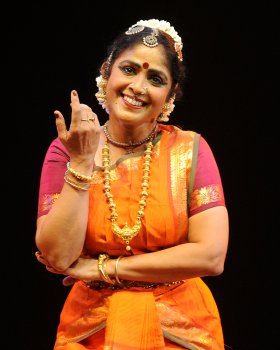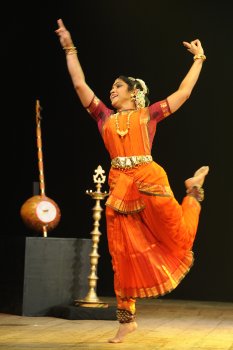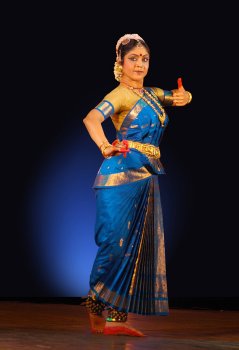
|
 |

|
 |
In conversation with Dr. Ananda Shankar Jayant - Priya Raman, Hyderabad e-mail: priyans03@gmail.com December 13, 2010  She surely is one person who lives up to her name! In a state of joy, bliss and emanating laughter into lives, 'Ananda'! India's very own and renowned Bharatanatyam and Kuchipudi dancer, rejuvenating in the after effect of the Padma Shri and the Sangeet Natak Akademi Award coming within a short span of three years, Dr. Ananda Shankar Jayant is a source of inspiration simply in the way she has lived her life! So when I as a young dancer, a rasika and more so a learner approached her, she was more than willing to chat over. Here are the excerpts. When I knocked at your door one day, I was told you were out of town. When quizzed if I could come next morning, pat came an answer 'She goes to work in the morning. Come during the evening hours.' A professional dancer holding a full time job? Well, I always knew I had to work. The bread and butter taken care of, I could concentrate on my dance sans compromises. I was also sure of the fact that I did not want to work in the art world. I felt it would hinder independent growth. So when Railways happened, it couldn't have been better. Today as the Senior officer of the Indian Railway Traffic Service, I have balanced dance and work quite satisfactorily. My administration experience from work helps make dance training more systematic and development oriented. As a dancer, I carry a certain harmony to the table and have an egalitarian attitude. You hold an MA in Indian History, MPhil in Art History and PhD in Tourism. Did that mean a lot of struggle and juggle? You and I are born South Indians! Rest assured it is a given fact that arts and academia need to go hand in hand. And as tradition has it, I had convent education in the science stream, was a gold medalist and an all rounder in school. This is when much to everyone's surprise my mother forayed my entry into Kalakshetra, when I was all of eleven years with a scholarship to study performing arts. Rukmini Athai (Rukmini Devi Arundale) insisted on full time dancing and having an academic tutor. I did Bachelors through correspondence and took up MA only to experience campus life. My friends were taking the UPSC exams for entry into Civil Services and suggested I should take a plunge. I joined the Indian Railways after taking the exams. MPhil and PhD were more my own pursuit of academics. My mother was constantly worried of me landing up with a 9 to 5 job leaving behind all the dancing, though I kept assuring her of not giving up on dance. But I guess I have done well for myself. In an informal lecture demonstration that Geeta Chandran presented in Hyderabad, you expressed concern over the reducing numbers of youngsters in this art form. How do you see this trend changing for the better? As a teacher, I am worried, obviously concerned. I see that there is a lack of commitment in this generation. The giving up is happening rather easily and early. Until a few years back, I was confident that I would have a good student with me at least until her first child. Now the scene is diminishing as they join professional courses. The balancing act is not being understood well. But again on the flip side, youngsters unlike us do not have a flexible / relaxed work life. It's vague, erratic and demanding. Add to that, a career in dance comes nowhere close to monetarily satisfactory. Non-existence of space for solo dancing coupled with no proper funding methodologies is adding to the sad state of affairs. I wonder if a space can be created for artistes with sufficient funding. When there can be quotas for sports, why not a cultural quota. It is only weighed in terms of medals which dance cannot bring. Dance is only needed to showcase identity! This is all a vicious circle.  Is the traditional margam losing its way to new experiments and light dancing? Change is a process, an inevitable process. Traditional margam has its space, but its connect with the audience has changed. The time when margam started to be performed, there were few dancers and this paved the way for a one on one connection. Today, the attention span of the audience has considerably reduced owing to a wide range of options and larger exposure. Content of the margam is irrelevant today. Margam always has a nayika pining and at the door. We might not be in such circumstances today. It also remains that opportunities for solo performances are on the lower side in the ratio of existing dancers. Dancers yearning to perform and not having the ability to pull off a solo, find some solace in taking to stage through group productions. The audience also look out for and enjoy group productions as a visual treat. Fair enough! Your opinion on the Hyderabad dance scenario. Hyderabad is a cosmopolitan city. It is a film place, a corporate hub and culture is a part of all this, not a very visible part like in Chennai. Going by the Sabha culture, there are very few sabhas, in fact, two or three like the South Indian Cultural Association (SICA), Kala Sagaram etc that actively promote dance. Hyderabad is known as a convention centre where corporate dancing is booming. It is well paid and serves the purpose of dancers to invest the money in quality dancing, which is good. You have had productions like 'Darshanam - An ode to the Eye' and 'Dancing Tales -Panchatantra,' two differently crafted pieces. Is it directed towards different audiences? Not it's not the audience that has been in question. Neither have they been planned. All my productions have been an outcome of an urge to give a message and say something. I play with the form and content. If something tickled me, then I would go ahead and say it through dance. 'Jonathan Livingston Seagull' happened when I was reading the book and felt I must give this a shot. When gender issues annoyed me, I let out the frustration in 'What About Me?' 'Navarasa - Expressions of Life' is a production with only nritta and swaras. I felt one does not need a story always. And once in a program, I saw only octogenarians seated in the audience, when I felt I should bring in the younger crowd, initiate them and this is how 'Dancing Tales - Panchantantra' happened. So the trigger can come from anywhere. I am only trying to open a window.  What is your line of discipline at Shankarananda Kalakshetra? Dance in its unknown frontiers has lots of silent by-products - discipline, focus, grace, aesthetic value, a sense of democracy - and turns one into a different human being. This is what I try to emanate in my class. I feel that it is only practice and commitment that can take one forward. When a student comes to class, she is one among all; she may be a princess of a nuclear family but only good work would fetch her kudos here! That's for the technical part and beyond that I am a friendly teacher whom students share their secrets with. Do the spiritual underpinnings of art connect to the audience? Yes, it does! Very much. How you present and package is what matters. A product with a lot a research, commitment, in depth understanding, proper layering and elegant communication will definitely touch the audience. Finally, an SNA awardee, how does it feel? Is it more of a responsibility? Oh! It feels on top of the world. A pat on the back saying, "You are on the right path, go ahead." A great blessing. I would not want to see it as a responsibility but as a challenge to push the envelope further. Questions on how she battled Cancer have not been featured for she has gracefully said it all in a number of previous occasions. The fact remains that she has beautifully come through it which is there to see as her work speaks! e-mail: anandasj@rediffmail.com Website: anandashankarjayant.com |